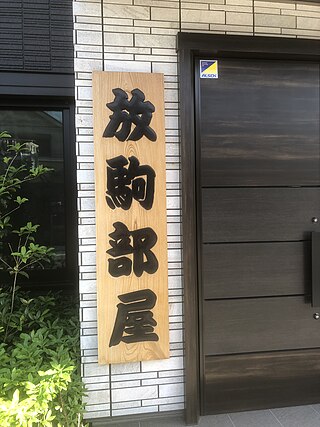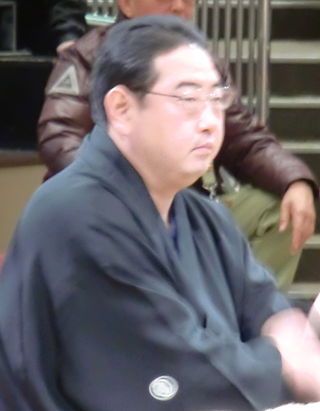Related Research Articles

Tōki Susumu is a former sumo wrestler from Ichikawa, Chiba Prefecture, Japan. His highest rank was komusubi. Wrestling for Takasago stable, he was a sumo coach at two other stables until his retirement in 2023.

Kitanofuji Katsuaki was a Japanese professional sumo wrestler from Asahikawa, Hokkaidō. He made his professional debut in 1957, reaching the top makuuchi division in 1964. He was the sport's 52nd yokozuna, a rank he attained in 1970. He won ten tournament championships and was known for his rivalry with Tamanoumi. He retired in 1974 and was the head coach of Kokonoe stable from 1977 to 1992. He left the Japan Sumo Association in 1998, but was still prominent in the sumo world as a commentator in his later years.

Kokonoe stable is a stable of sumo wrestlers, one of the Takasago group of stables. It was formed in 1967 and until 2021 was located in Ishiwara, Sumida, Tokyo. As of January 2023 it had 26 sumo wrestlers, four of whom are of sekitori rank. It is the most successful stable in terms of total yūshō won by its wrestlers, with 52.

Hokutōriki Hideki is a former sumo wrestler, from Tochigi, Japan. He reached the top makuuchi division in 2002 and was runner-up in three tournaments. He had four special prizes in his career and a gold star for defeating yokozuna. The highest rank he reached was sekiwake. He retired in May 2011 and is an elder of the Japan Sumo Association and a coach at Kokonoe stable.

Chiyonoyama Masanobu was a Japanese professional sumo wrestler from Fukushima, Hokkaidō. He was the sport's 41st yokozuna from 1951 until 1959. He is regarded as the first "modern" yokozuna in that he was promoted by the Japan Sumo Association itself and not the House of Yoshida Tsukasa. He was the first yokozuna from Hokkaidō, which was also the birthplace of the subsequent yokozuna Yoshibayama, Taihō, Kitanoumi and his own recruits Kitanofuji and Chiyonofuji. After his retirement he left the Dewanoumi group of stables and founded Kokonoe stable in 1967. He died in 1977 while still an active stablemaster.

Wakanosato Shinobu is a retired sumo wrestler from Hirosaki, Aomori, Japan. He made his debut in the top division in 1998, and his highest rank was sekiwake. He holds the record for the most consecutive tournaments ranked in the junior san'yaku ranks of sekiwake and komusubi. He won ten special prizes and was twice runner-up in a tournament. He earned two gold stars for defeating yokozuna at a maegashira rank. He had 1691 career bouts, sixth on the all-time list. He retired in 2015 and was a coach at Tagonoura stable, until opening his own Nishiiwa stable in February 2018.
Kotofuji Takaya is a former sumo wrestler from Chiba City, Japan. His highest rank was sekiwake. In 1991 he won a top division yūshō or tournament championship from the maegashira ranks.

Wakashimazu Mutsuo is a Japanese former sumo wrestler from Nakatane, Kagoshima, Japan. His highest rank was ōzeki. He won two top division yūshō or tournament championships. He retired in 1987 and founded Matsugane stable in 1990.

Tsurugamine Akio, real name Akio Fukuzono, was a sumo wrestler from Aira, Kagoshima, Japan. His highest rank was sekiwake. He was twice runner-up in a tournament and won 14 special prizes, including a record ten for Technique, and earned ten gold stars for defeating yokozuna. After his retirement he was the head of Izutsu stable and coached two of his sons, Sakahoko and Terao, to the top division.

Hanaregoma stable, formerly known as Matsugane stable and Nishonoseki stable, is a stable of sumo wrestlers. It was founded in 1990 as Matsugane stable by Wakashimazu who branched out from the Futagoyama stable. It has produced five top makuuchi division wrestlers; Wakakoshō (2000), Wakatsutomu (2001), Harunoyama (2004), Shōhōzan (2011) and Ichiyamamoto (2021). After the retirement of Harunoyama in November 2006 the stable had no sekitori until Shōhōzan reached the jūryō division in March 2010. As of January 2023 it had 8 wrestlers.
Kotoryū Hiroo is a former sumo wrestler from Hyōgo, Japan. He joined professional sumo in 1987, reaching the top division in 1996. He defeated yokozuna three times and earned one Fighting Spirit Prize (kanto-sho). His highest rank was maegashira 1.
Ōuchiyama Heikichi was a sumo wrestler from Hitachinaka, Ibaraki, Japan. He made his professional debut in 1944, and reached the top makuuchi division in 1949. He reached the second highest rank of ōzeki in 1955, and was a runner-up in two tournaments. He was well known for his extraordinary size – at 2.02 m tall he was the tallest modern era ōzeki until Akebono in 1992. After his retirement in 1959 he worked as a coach at Tokitsukaze stable and Tatsutagawa stable until his death in 1985.
Ōzutsu Takeshi is a former sumo wrestler from Mie, Japan. Beginning his professional career in May 1971, he was ranked in the top makuuchi division continuously from March 1979 to January 1992, and his record of 1170 consecutive bouts there is the second best in history after Takamiyama. His highest rank was sekiwake. He was runner-up in one tournament and earned ten kinboshi or gold stars for defeating yokozuna. He also won four sanshō or special prizes. He wrestled for Taihō stable and after his retirement in May 1992 he worked there as a coach before leaving the Japan Sumo Association in 2008.
Tochitsukasa Tetsuo is a former sumo wrestler from Nakagawa, Nagoya, Aichi Prefecture, Japan. His highest rank was sekiwake. After his retirement from sumo in 1992 he became an elder of the Japan Sumo Association and established Irumagawa stable in 1993, which he ran until 2023.

Kotoinazuma Yoshihiro is a former sumo wrestler from Niiharu, Gunma, Japan. He made his professional debut in 1978, and reached the top division in 1987. His highest rank was komusubi and he earned two special prizes. After retirement he became an elder in the Japan Sumo Association and as of 2016 he is a coach at Sadogatake stable under the name Kumegawa.
Kitakachidoki Hayato is a former sumo wrestler from Obihiro, Hokkaidō, Japan. He made his professional debut in 1981, and reached the top division in 1989. His highest rank was maegashira 3. After retirement he became an elder in the Japan Sumo Association. He took over as head coach at Isenoumi stable, when former head coach Fujinokawa reached mandatory retirement age in September 2011.

Oginohana Akikazu is a former sumo wrestler from Ichikawa, Chiba, Japan. He made his professional debut in July 1983, and reached the top division in January 1990. His highest rank was maegashira 2. He retired in July 1998. He is the son of former sekiwake Oginohana Masaaki and the elder brother of former komusubi Oginishiki. Since 2014 he has been the head of the Dewanoumi stable.
Zaōnishiki Toshimasa, birth name Toshimasa Adachi, was a sumo wrestler from Yamagata, Japan. He made his professional debut in September 1970, and reached the top division in November 1976. His highest rank was maegashira 1. He retired in January 1983 and served as an elder in the Japan Sumo Association under several successive names. He reached the retirement age for elders of 65 in September 2017, but stayed with the Sumo Association for an additional two years as a consultant.

Wakasegawa Yoshimitsu was a sumo wrestler from Sakata, Yamagata, Japan. He made his professional debut in 1978, reaching the top makuuchi division for the first time in 1983. His highest rank was maegashira 1. He retired in 1992 and worked in the restaurant business after leaving sumo.
Kinoarashi Kazutoshi is a former sumo wrestler from Yūbari, Hokkaidō, Japan. He joined professional sumo in 1977 and reached the top makuuchi division in 1982. His highest rank was maegashira 2. He fell to the sandanme division through injury before staging a successful comeback to the top division in 1987. He retired in 1991.
References
- ↑ "Oyakata (Coaches)". Nihon Sumo Kyokai. Retrieved 17 August 2012.
- 1 2 3 4 Patmore, Angela (1990). The Giants of Sumo. MacDonald & Co. p. 101. ISBN 0356181200.
- ↑ Sharnoff, Lora (1993). Grand Sumo. Weatherhill. p. 104. ISBN 0-8348-0283-X.
- ↑ "Fujinoshin Tsukasa Rikishi Information". Sumo Reference. Retrieved 2 September 2012.